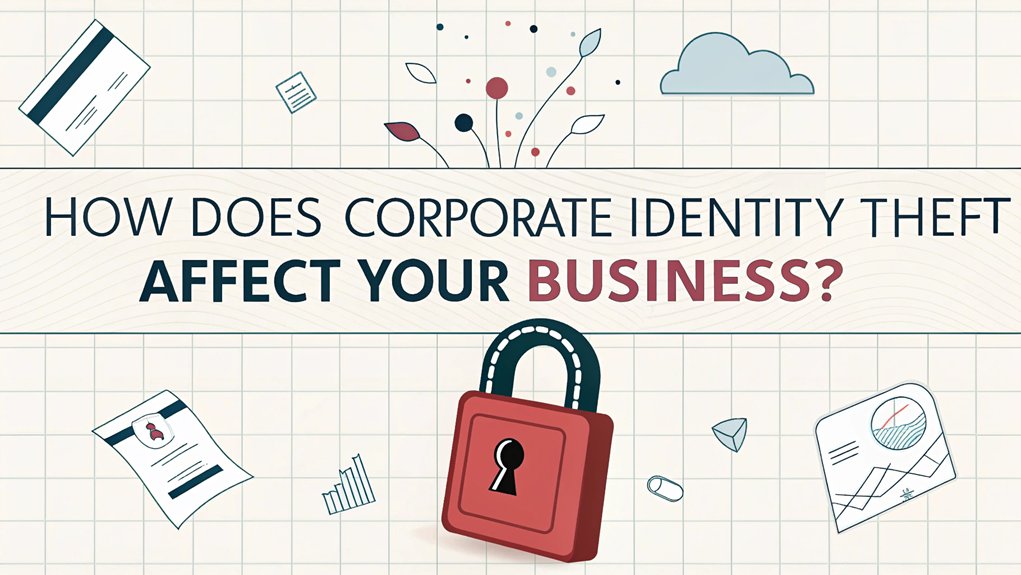Corporate identity theft is a serious issue that can have devastating consequences for businesses, akin to having your lunch money stolen but on a much larger scale! Cybercriminals often impersonate legitimate businesses to pilfer funds and sensitive information, which can feel like a deceptive game of dress-up with dire outcomes. Recent statistics show that businesses lost a staggering $56.6 billion last year due to these cunning thieves. To combat this threat, it's essential for companies to become security superheroes, employing effective strategies to safeguard themselves against these fraudulent impostors.
Key Highlights
- Businesses face immediate financial losses from unauthorized purchases and fraudulent transactions, with U.S. companies losing $56.6 billion in 2022.
- Identity theft leads to costly investigations, increased insurance premiums, and potential legal fines if customer data is compromised.
- Criminals can obtain business credit cards with high spending limits up to $150,000, creating substantial unauthorized debt.
- Company reputation suffers when security breaches occur, affecting customer trust and long-term business relationships.
- Recovery requires extensive resources, including time spent reporting incidents, reviewing credit reports, and implementing new security measures.
Understanding Corporate Identity Theft in Today's Digital Age
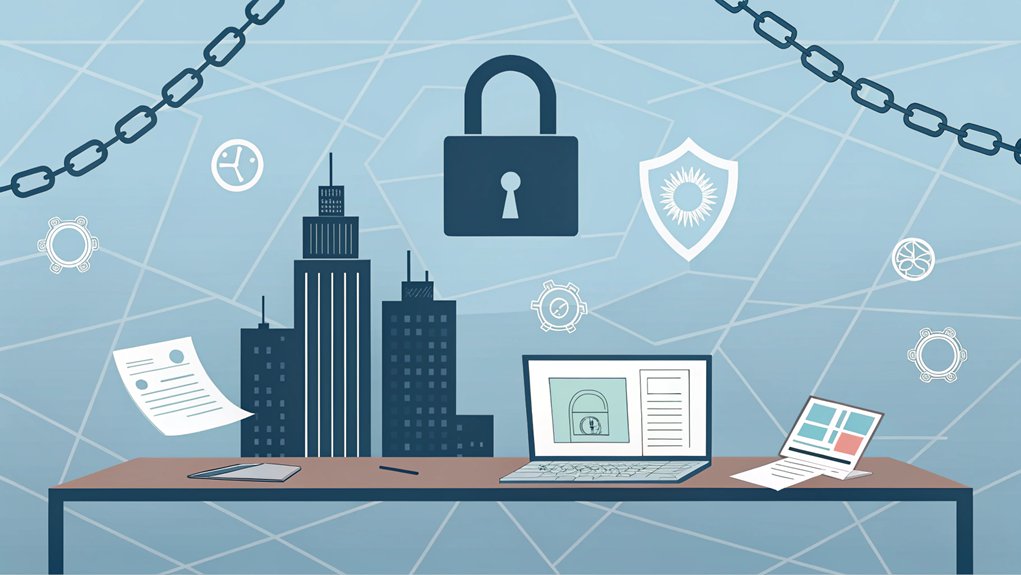
While you might think that stealing only happens to people's backpacks or lunch money, there's something called corporate identity theft that's like stealing from big companies!
Imagine if someone pretended to be your favorite pizza place and took all their money – that's what bad guys try to do to businesses!
You know how your parents keep their credit cards safe? Companies need to do that too, but with lots more stuff!
They've to protect things like their computer passwords, bank accounts, and secret recipes (just like how you wouldn't want anyone stealing your special cookie-making technique!).
Want to know something scary? These sneaky thieves use tricks like sending fake emails or pretending to be someone they're not.
It's like playing dress-up, but for bad reasons!
Last year, businesses across America lost a whopping $56.6 billion because of identity theft and fraud.
Common Types of Business Identity Theft Attacks
Let's talk about the sneaky ways bad guys try to steal from businesses! You know how sometimes your friend might pretend to be you on the playground? Well, these tricky people do something similar – they pretend to be business owners or employees to steal money and information!
Think of it like playing dress-up, but with bad intentions. Some thieves create fake websites that look just like real company pages, kind of like making a copycat version of your favorite toy store. These criminals can even get business credit cards with spending limits of up to $150,000.
Others dig through trash (yuck!) looking for secret papers, or send sneaky emails trying to trick people into sharing passwords.
Would you believe that almost 8 out of 10 businesses have dealt with identity thieves? That's like having almost everyone in your class experience the same problem!
Financial Impact on Your Company's Bottom Line
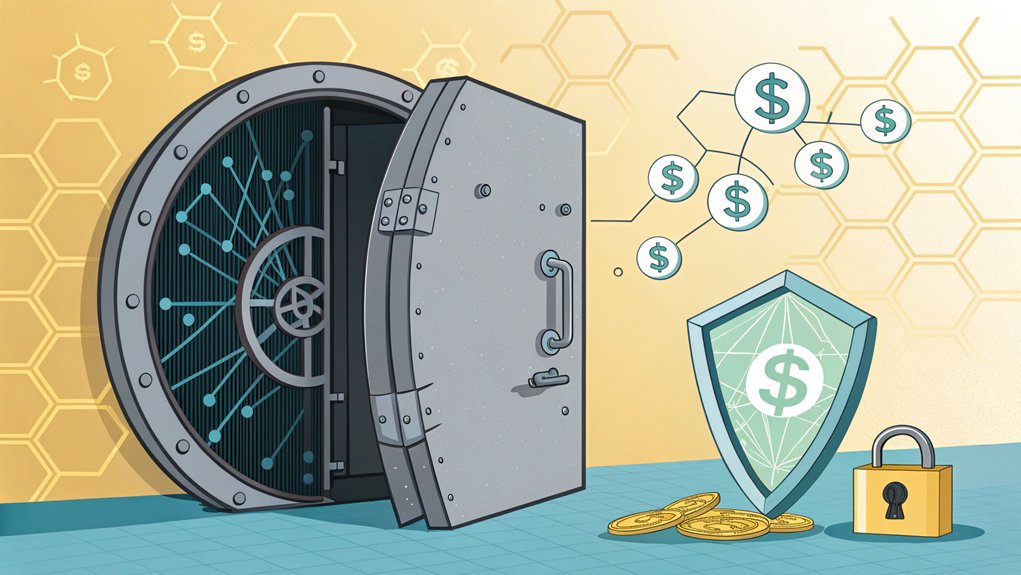
Identity theft can hit your business's piggy bank hard! When bad guys steal your company's identity, it's like someone taking your lunch money – but way worse! Your business can lose money right away from fake purchases, and you'll need to spend extra cash to fix the mess. Legal consequences and fines can drain your finances if you fail to protect customer data. Implementing multi-factor authentication can significantly reduce the risk of identity theft and unauthorized access.
| Cost Type | What Happens | How Bad Is It? |
|---|---|---|
| Quick Loss | Money stolen | Super expensive! |
| Fix-it Fees | Investigation costs | Makes you say "ouch!" |
| Future Problems | Higher insurance costs | Long-lasting pain |
Think of it like dropping your ice cream cone – it's not just about losing the ice cream, but now you need to clean up the mess and buy a new one. The worst part? These money troubles can stick around for months or even years, just like a bandage that won't come off!
Protecting Your Business Assets and Data
Now that you know how costly identity theft can be, let's talk about keeping your business safe – like putting a super-strong lock on your treehouse!
You wouldn't leave your favorite toys out in the rain, right? Well, your business needs the same kind of protection! Modern attacks using deepfake technology are making it harder than ever to spot fraud. Implementing multi-factor authentication can significantly enhance your security measures.
Think of it like being a superhero protecting your secret hideout. You'll want to check your business credit reports (they're like your superhero report card), keep important numbers safe (just like a secret code), and teach your team about cybersecurity (it's like teaching friends the rules of a new game).
I love using alerts – they're like having a friendly guard dog that barks when something's not right!
The best part? When you protect your business well, the bad guys can't get in!
Warning Signs Your Business Has Been Compromised
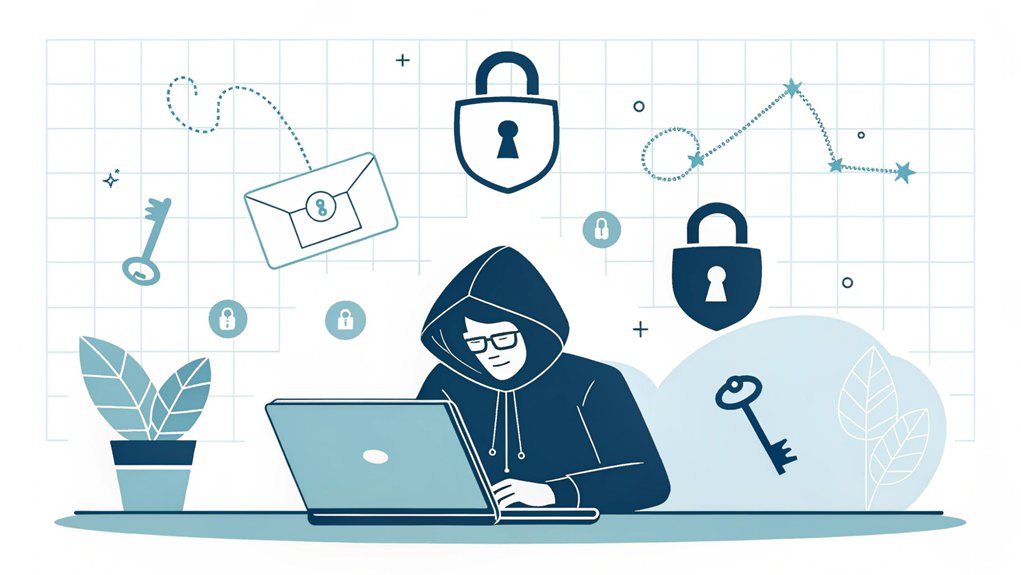
Ever wondered how to spot the sneaky tricks that bad guys might play on your business? It's like being a detective looking for clues! I'll help you spot the warning signs.
Watch out if you get strange emails asking for secret information – that's like someone trying to peek at your diary!
Notice if bills show up for things you didn't buy, or if your boss seems to be asking for money transfers when it doesn't feel right. These scams have cost businesses millions in losses through fraudulent activities.
Keep an eye on your tax paperwork too. If the IRS says they already got your forms, something's fishy!
Also check if someone's messing with your business address or website – just like if someone copied your favorite toy and pretended it was theirs.
Essential Security Measures for Prevention
Protecting your business is like having a super-strong shield around your castle! Just like how you keep your favorite toys safe, I'm going to show you how to keep business information super secure. American companies lose billions annually from identity theft and fraud. Implementing multi-factor authentication is an effective way to enhance security and protect sensitive information.
| Security Must-Dos | Why It's Important |
|---|---|
| Shred old papers | Like turning paper into confetti! |
| Use strong passwords | Think of it as your secret clubhouse code |
| Install protective software | Like having a security guard for your computer |
I'm always extra careful with important information – it's like keeping your lunch money in a special pocket where no one can find it! Remember to use secure passwords (not just your pet's name!), and teach your team to be careful too. Isn't it amazing how we can protect our digital castle?
Recovery Steps After Identity Theft
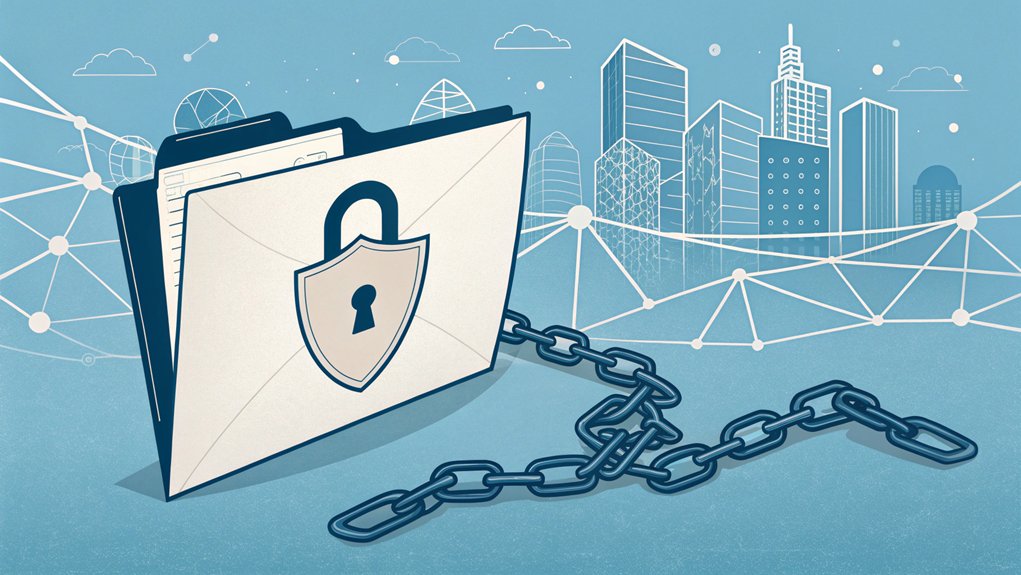
When bad guys try to steal your business's identity, it's like someone taking your favorite backpack without asking!
But don't worry – I'll show you how to get it back and keep it safe.
First, you'll need to tell the police, just like you'd tell a teacher if someone took your lunch.
Then, it's time to be a detective! I'll help you check your credit report (that's like your business's report card) and alert the credit bureaus (they're like the playground monitors of money).
Next, you'll want to contact your bank and change all your passwords – kind of like creating a new secret hideout! Make sure to get a free credit report from each of the three major bureaus to check for any suspicious activity.
Remember to tell everyone who works with you about what happened, so they can help keep watch.
Think of it as building a super-strong fortress around your business!
Building a Strong Security Culture Within Your Organization
Now that you know how to bounce back from identity theft, let's build a security fort around your business!
Think of your company like a big treehouse club. Just like you need rules for who can climb up, your business needs security rules too!
I'll show you how to make everyone in your company become security superheroes.
First, your bosses need to be like team captains – they show everyone how to play it safe.
Then, we train all your employees (that's like teaching everyone the secret handshake). We make sure everyone knows how to spot bad guys trying to trick them online – just like spotting someone who's "it" in hide-and-seek!
Let's create clear rules, like setting up strong passwords and using special codes to log in. Regular security audits and assessments help us find any weak spots in our defenses.
It's like having a super-secret decoder ring for your computer!
Frequently Asked Questions
How Long Does It Typically Take to Fully Recover From Corporate Identity Theft?
I'll tell you straight up – recovering from corporate identity theft isn't quick!
Think of it like cleaning up after a big mess. Sometimes it's like picking up a few toys (just a few days), but other times it's like organizing your whole room (several years).
If you catch the bad guys early, it's faster. But if they've made a huge mess with your company's information, it'll take longer to fix everything.
Are Identity Theft Protection Services Worth the Investment for Small Businesses?
I'd say yes, identity theft protection is totally worth it for small businesses!
Think of it like a superhero shield that guards your company's secrets. Just like you wouldn't leave your favorite toy outside in the rain, you shouldn't leave your business data unprotected.
These services watch over your information 24/7, send alerts if something's fishy, and help fix problems if bad guys try to steal your business identity.
Can Business Insurance Policies Cover Losses From Corporate Identity Theft?
Yes, I've got great news for you! Business insurance can definitely help protect your company from identity theft losses.
Think of it like a safety net – it can help pay back stolen money (up to $100,000!), cover legal fees (up to $1 million), and even help fix your credit.
It's like having a superhero shield that protects your business from bad guys trying to steal your identity!
How Often Should Businesses Update Their Incident Response Plans?
I recommend updating your incident response plan at least once a year – that's like giving your bike its yearly tune-up!
But don't wait if big changes happen. When you get new computers, hire new team members, or hear about scary new cyber threats, it's time for an update.
Think of it like checking your favorite game for cool new features – you want to stay current, right?
What Legal Rights Do Businesses Have When Their Identity Is Stolen?
Let me tell you about your rights when someone steals your business identity!
You can get free copies of any fraudulent transactions within 30 days. I bet you didn't know you can have the police look at those records too!
You're protected by law to report the theft and get help fixing it.
Plus, you can take legal action – just like a superhero defending their secret identity!
The Bottom Line
In today's digital landscape, protecting your business from identity theft is more critical than ever. One of the most effective strategies is to enhance your password security and management. Weak passwords can be a gateway for cybercriminals, jeopardizing your sensitive information and your company's reputation. That's why implementing robust password management and passkey management solutions is essential.
Don't wait until it's too late! Take proactive steps to safeguard your business by utilizing advanced password management tools that can help you create, store, and manage strong passwords securely. I encourage you to explore the benefits of secure password management by signing up for a free account at LogMeOnce. By taking this step, you can reduce the risk of corporate identity theft and protect your business for the future. Your business's security starts with you today!

Mark, armed with a Bachelor’s degree in Computer Science, is a dynamic force in our digital marketing team. His profound understanding of technology, combined with his expertise in various facets of digital marketing, writing skills makes him a unique and valuable asset in the ever-evolving digital landscape.





 Password Manager
Password Manager
 Identity Theft Protection
Identity Theft Protection

 Team / Business
Team / Business
 Enterprise
Enterprise
 MSP
MSP
